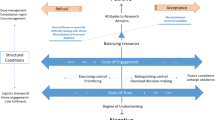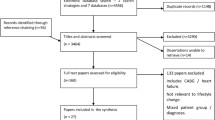Abstract
The aim of this paper is to investigate whether or not ethical conflicts can be identified, analysed and solved using ethical principles. The relation between the physician and the patient with ischemic heart disease (IHD) as life style changes are recommended in a secondary prevention program is used as an example. The principal persons affected (the patient and his or her spouse) and the ethical principles (respect for autonomy, non-maleficence, beneficence and justice) are combined in a two dimensional model. The most important person affected by the recommendations is the patient. His or her autonomy is challenged by the suggested life style changes, the purpose of which is to promote the future wellbeing and health of the patient. The spouse is indirectly involved in and affected by the process. He or she often feels neglected by caregivers. Ethical conflicts can both be identified and analysed using ethical principles, but often no solution is implied. Most (if not all) physicians would strongly encourage life style changes, but surprisingly there is no uncontroversial justification for this conclusion using principles.
Similar content being viewed by others
Abbreviations
- CABG:
-
Coronary artery by-pass grafting
- IHD:
-
Ischemic heart disease
- PCI:
-
Percutanous coronary intervention
References
Beauchamp T, Childress J (2001) Principles of biomedical ethics (5th edn). Oxford University Press, Oxford.
Brady A, Oliver M, Pittard J (2001) Secondary prevention in 24 431 patients with coronary heart disease: survey in primary care. Br Med J 322:1463
Bremberg S (2004) Paternalism in general practice—physician’s power and patient’s autonomy. (Thesis) Department of Medical Ethics, Lund University, Lund.
Carlsson R, Lindberg G, Westin L, Israelsson B (1997) Influence of coronary nursing management follow-up on lifestyle after acute myocardial infarction. Heart 77:256–259
CIOMS (Council for International Organizations of Medical Sciences) (2002) International Ethical Guidelines for Biomedical Research Involving Human Subjects. Geneva
Dalal H, Evans P, Campbell J (2004) Recent developments in secondary prevention and cardiac rehabilitation after acute myocardial infarction. Br Med J 328:693–697
Ford J, Reutter L (1990) Ethical dilemmas associated with small samples. J Adv Nurs 15:187–191
Gillon R, Lloyd A (eds) (1994) Principles of health care ethics. John Wiley & Sons, Chichester
Hentinen M (1983) Need for instruction and support of the wives of patients with myocardial infarction. J Adv Nurs 8:519–524
Kant I (1785) Grundlegung zur Metaphysik der Sitten, Hamburg
Kettunen S, Solovievas S, Laamenen R, Santavirta N (1999) Myocardial infarction, spouses’ reactions and their need of support. J Adv Nurs 30:479–488
Lerner D, Kannel W (1986) Patterns of coronary heart disease morbidity and mortality in the sexes: a 26-year follow-up of the Framingham population. Am Heart J 111:383–390
Lukkarinen H, Kyngäs H (2003) Experiences of the onset of coronary artery disease in a spouse. Eur J Cardiovasc Nurs 2:189–194
Moser D, Dracup K, Marsden C (1993) Needs of recovering cardiac patients and their spouses: compared views. Int J Nurs Stud 30:105–114
Murray C, Loopez A (1997) Mortality by cause for eight regions of the world: Global Burden of Disease Study. Lancet 349:1269–1276
Nilstun T, Melltorp G, Hermerén G (2000) Survey on attitudes to active euthanasia: to draw normative conclusions is problematic. Scand J Pub Health 28:111–116
Nilstun T, Sjöquist P (2001) From fact to recommendation: explicit value premises makes the conclusions more convincing. J Intern Med 249:121–125
Nilstun T (1990) Public health measures with HIV-infection. A model for identification and analysis of ethical conflicts. In: Allebeck P, Jansson B (eds) Ethics in Medicine: Individual Integrity Versus Demands of Society (pp 203–213). Raven Press, New York
Official Statistics of Sweden. National Bureau of Statistics (1994) Causes of death 1992. Statistics Sweden, Stockholm
Official Statistics of Sweden. The National board of health and welfare, centre for epidemiology. Causes of death 2002. Web document published September 2004. http://www.socialstyrelsen.se
Orth-Gomer K, Unden A, Edwards M (1988) Social isolation and mortality in ischemic heart disease. A 10-year follow-up study of 150 middle-aged men. Acta Medica Scand 224:205–215
Orwell G (1996) Animal farm. Longman, Harlow (originally published 1945)
Quist-Paulsen P, Gallefoss F (2003) Randomised controlled trial of smoking cessation intervention after admission for coronary heart disease. Br Med J 327:1254–1257
Rigotti N, McKool K, Shifferman S (1994) Predictors of smoking cessation after coronary artery bypass graft surgery. Ann Intern Med 120:287–293
Rosengren A, Spetz C, Köster M, Hammar N, Alfredsson L, Rosén M (2001) Sex differences in survival after myocarical infarction in Sweden. Eur Heart J 22:314–322
Rosengren A, Wallentin L, Gitt A, Behar S, Battler A, Hasdai D (2004) Sex, age, and clinical presentation of acute cononary syndroms. Eur Heart J 25:663–670
Ruhnke G, Wilson S, Akamatsu T, et al (2000) Ethical decision making and patient autonomy: a comparison of physicians and patients in Japan and the United States. Chest 118:1172–1182
Simons-Morton D, Calfas K, Oldenburg B, Burton N (1998) Effects of interventions in health care settings on physical activity or cardiorespiratory fitness. Am J Prev Med 15:413–430
Singer P (1979) Practical Ethics. Cambridge University Press, Cambridge.
Solzhenitsyn A (1997) The first circle. Northwestern University Press, Evanston (orig. published 1968)
Stewart M, Davidson K, Meade D, Hirth A, Makrides L (2000) Myocardial infarction: survivors’ and spouses’ stress, coping, and support. J Adv Nurs 31:1351–1360
Swedish Medical Products Agency. Web document from a seminary on natural remedies, November 2004. http://www.mpa.se/naturlakemedel/seminarium/041110_alvan.pdf
Williams R, Barefoot J, Califf R, et al (1992) Prognostic importance of social and economic resources among medically treated patients with angiographically documented coronary artery disease. JAMA 267:520–524
Wilson K, Gibson N, Willan A, Cook D (2000) Effect of smoking cessation on mortality after myocardial infarction. Meta-analysis of Cohort Studies. Arch Intern Med 160:939–944
Wood D, EUROSPIRE I and II group (2001) Clinical reality of coronary prevention guidelines: a comparison of EUROSPIRE I and II in nine countries. Lancet 357:995–1001
Author information
Authors and Affiliations
Corresponding author
Rights and permissions
About this article
Cite this article
Westin, L., Nilstun, T. Principles Help to Analyse But Often Give No Solution—Secondary Prevention after a Cardiac Event. Health Care Anal 14, 111–117 (2006). https://doi.org/10.1007/s10728-006-0016-6
Published:
Issue Date:
DOI: https://doi.org/10.1007/s10728-006-0016-6




